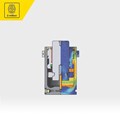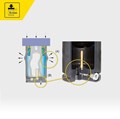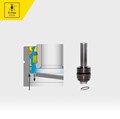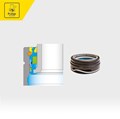Gas Spring Safety Features
KALLER® takes safety seriously, so our products have integrated safety features to reduce the risk of personal injury, damage, and liabilities.

PED Approved
KALLER Gas Springs are designed, manufactured, and tested to withstand a minimum of 2,000,000* full strokes according to PED 2014/68/EU at max charging pressure, max operating temperature, and for all approved mounting methods.
*Estimated value for fatigue.
Customer Value
High safety and reliability during the entire product life. Repair kits and training through KALLER with partners, providing increased efficiency and reliability.

Protection Against Overstroke
During an over stroke, conventional Gas Springs may burst because of pressure build-up, and components may come loose and be ejected.
Possible Cause
The tool may have no mechanical stop to limit the stroke or improper installation.
KALLER Difference
In the event of an over stroke, the patented safety protections are designed to evacuate the gas in a controlled manner. Either the cylinder tube is deformed in a predefined way (A), or the piston rod destroys the safety plug in the bottom of the Gas Spring (B).
Customer Value
Achieve a safer working environment and reduced risk of damage to the tool.

Protection Against Overload
If tool components get stuck, followed by the piston rod being released from its compressed position, conventional Gas Springs may pose a safety risk as the rod is not retained.
Possible Cause
Jamming components, such as a blank holder, cam, ejector, or stripping function, get stuck and then suddenly get loose.
KALLER Difference
Optimized guide and a patented safety stop on the piston rod. If the speed is too high during the return stroke, the piston rod automatically breaks off, and the integrated safety stop destroys the seal, which releases gas in a controlled manner.
Customer Value
Achieve a safer working environment and reduced risk of damage to the tool.

Protection Against Overpressure
If the internal gas pressure exceeds a maximum allowable limit, conventional Gas Springs may burst and pose a safety risk for tools and operators.
Possible Cause
The internal pressure is charged too high, or fluid enters the Gas Spring.
KALLER Difference
If the internal gas pressure exceeds a maximum allowable limit, the safety lip will be activated, releasing the gas in a controlled manner.
Customer Value
Achieve a safer working environment and reduced risk of damage to the tool.

Training
KALLER Gas Springs are used in various industrial applications where safety is critical. Proper training on Gas Springs can help users understand the safe handling, installation, and operation while reducing the risk of accidents or injuries caused by improper usage.
In-person and online training are both available through KALLER. The KALLER Academy allows you to learn at your speed, on your own time, when it is the most convenient. Training from a KALLER expert offers the opportunity to ask questions and receive immediate answers, anecdotes, and examples for a comprehensive understanding of best practices.
Visit our training page to learn more!